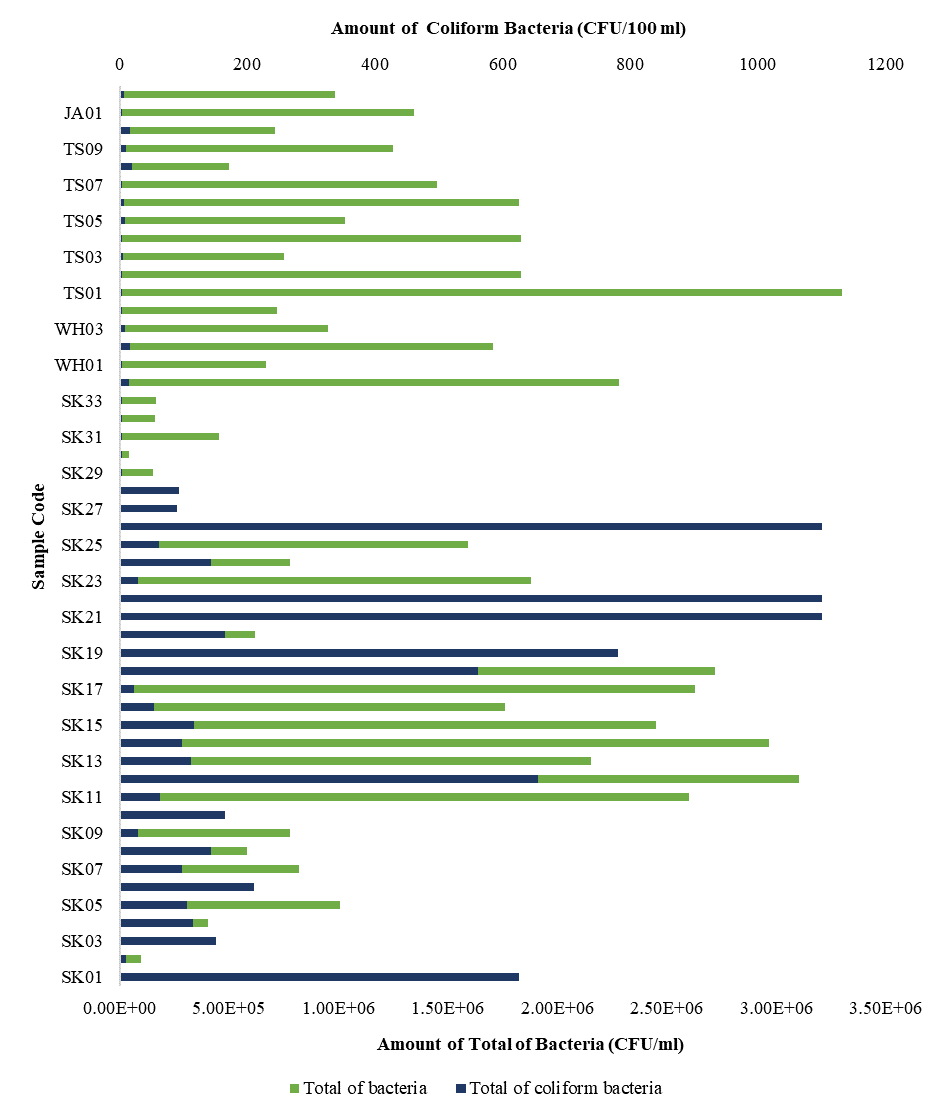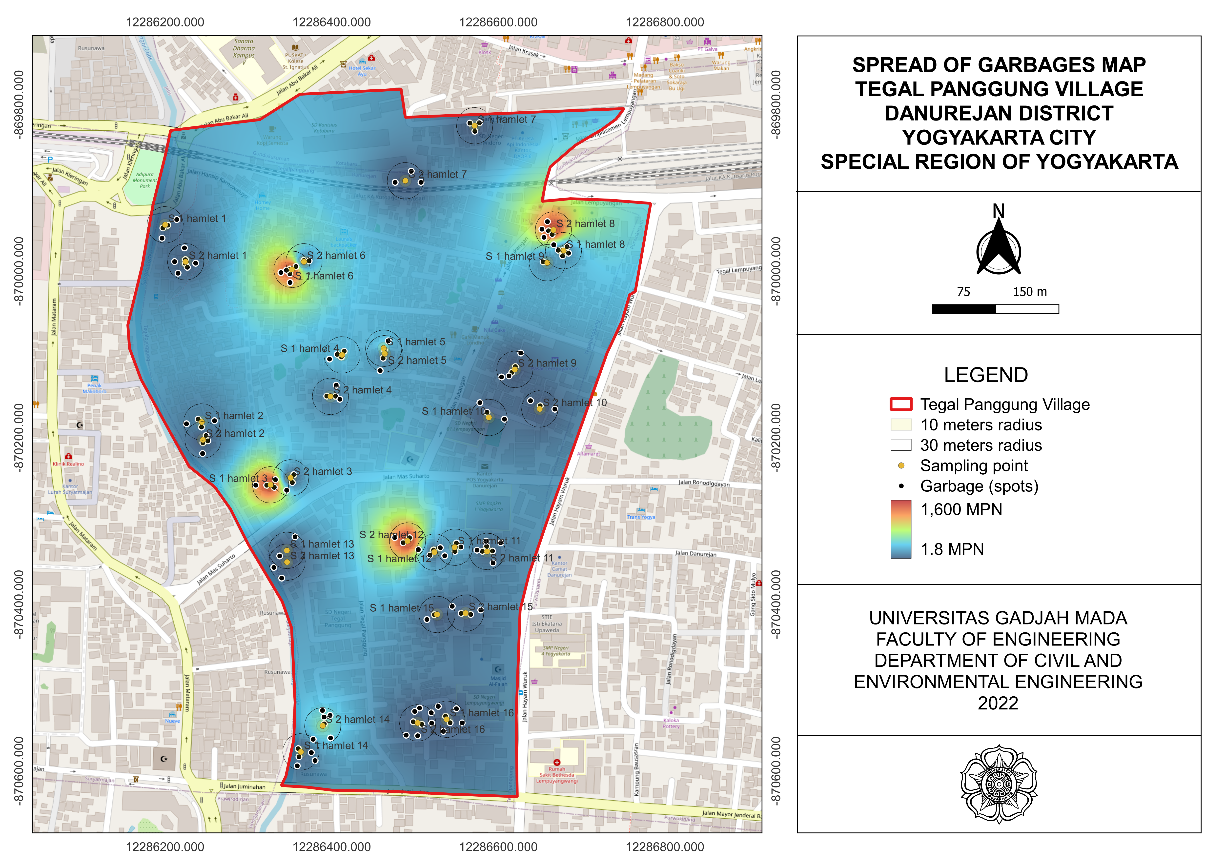Model of Community-Led Total Sanitation Pillar One: Open Defecation Free in Sagulung Subdistrict, Batam City
Downloads
Introduction: Community-Led Total Sanitation (CLTS) is an effort by the government to improve public health. The main focus of pillar one is to stop open defecation. Sagulung Subdistrict has verified and non-verified ODF villages in their working area. This paper aims to create a CLTS model based on the pillar of one ODF in the Sagulung Subdistrict. Methods: This research used a mixed-method that combining qualitative and quantitative approaches. An amount of 90 families were chosen as respondents using a simple random sampling technique. Besides that, three programmers and five implementers from the government also became respondents. Data were analysed with a Chi-Square test and descriptive analysis. Results and Discussion: This research showed that ODF declaration and local policies were the aspects that had not been fulfilled to the maximum on CLTS pillar one in the Sugulung Subdistrict Government. Sungai Lekop Primary Health Care had not fully fulfilled three aspects: the concept, planning, and targets (advocated and local policies). As a Non-ODF village, Sungai Langkai primary health care did not fulfil the concept, planning, and target (certificate of the training program, advocated, declaration of ODF and local policies). Conclusion: Variables that have not been fulfilled optimally can be arranged as a recommendation model to successful ODF in Sagulung Subdistrict.
Rathomi HS, Nurhayati E. Hambatan dalam Mewujudkan Open Defecation Free. J Integr Kesehat Sains. 2019;1(1):68–73. https://doi.org/10.29313/jiks.v1i1.4325
Ananda NJ. Perbedaan Antara Praktik Buang Air Besar di Desa ODF dengan Desa Belum ODF di Wilayah Kerja Puskesmas Mejayan. Skripsi. Madiun: Stikes Bhakti Husada Mulia Madiun;
Ministry of Health of Republic Indonesia. Health Profile of Indonesia 2019. Jakarta: Ministry of Health of Republic Indonesia; 2019. p. 1–497.
Fitrianingsih, Wahyuningsih S. Analisis FaktorFaktor yang Mempengaruhi Perilaku Buang Air Besar Sembarangan (BABS). J Sanitasi dan Lingkung. 2020;1(2):52–57. https://e-journal.sttlmataram.ac.id/index.php/jsl/article/view/22/13
Salleh SNA, Zin NSM, Othman N. A Review of Wastewater Treatment using Natural Material and Its Potential as Aid and Composite Coagulant. Sains Malaysiana. 2019;48(1):155–164. http://dx.doi.org/10.17576/jsm-2019-4801-18
Berber I, Avsar C. Investigating Some Microbial Pollution Parameters of Seawater and Mussels ( Mytilus galloprovincialis , Lamarck 1819 ) of SÑ–nop Black Sea Coastal Zone, Turkey. Sains
Malaysiana. 2014;43(12):1835–1842. http://www.ukm.my/jsm/english_journals/vol43num12_2014/
contentsVol43num12_2014.html
Subedi DP, Tyata RB, Khadgi A, Wong CS. Physicochemical and Microbiological Analysis of Drinking Water Treated by Using Ozone (Analisis Fisikokimia dan Mikrobiologi Air Minimum yang
dirawat dengan Ozon ) Physicochemical and Microbiological Analysis of Drinking Water Treated by Using Ozone. Sains Malaysiana. 2012;41(6):739–745. http://www.ukm.my/jsm/english_journals/vol41num6_2012/contentsVol41num6_2012.html
Lemeshow S, Jr DWH, Klar J, Lwanga SK. Adequacy of Sample Size in Health Studies. England: John Wiley & Sons Ltd.; 1990. 1–247 p. http://apps.who.int/iris/bitstream/10665/41607/1/0471925179_eng.
Foeh C, Joko T, D Hanani Y. Evaluasi Pelaksanaan Pilar Pertama Stop Buang Air Besar Sembarangan pada Program Sanitasi Total Berbasis Masyarakat di Kabupaten Nagekeo. J Kesehat Masy. 2019;7(4):749–758. https://ejournal3.undip.ac.id/index.php/jkm/article/view/24518/22644
Davik FI. Evaluasi Program Sanitasi Total Berbasis Masyarakat Pilar Stop BABS di Puskesmas Kabupaten Probolinggo. J Adm Kesehat Indones. 2016;4(2):107–116. https://doi.org/10.20473/jaki.v4i2.2016.107-116
Budhathoki SS, Shrestha G, Bhattachan M, Singh SB, Jha N, Pokharel PK. Latrine Coverage and Its Utilisation in a Rural Village of Eastern Nepal: A Community-Based Cross-Sectional Study. BMC
Res Notes. 2017;10(1):1–7. https://doi.org/10.1186/s13104-017-2539-3
Josphat M, Kimathi G. Lessons Learnt from Implementation of Outcome Linked Community Led Total Sanitation Intervention in Busia Kenya. 40th WEDC Int Conf. 2017;1(1):1–6. https://repository.lboro.ac.uk/articles/Lessons_learnt_from_implementation_of_outcome_linked_community_led_total_sanitation_intervention_in_Busia_Kenya/9589391/files/17228513.pdf
Dafitri A, Raharjo BB. Implementasi Rencana Aksi Daerah Percepatan Kabupaten Demak Bebas Buang Air Besar Sembarangan. Higeia J Public Heal Res Dev. 2020;1(3):23–32. https://journal.unnes.ac.id/sju/index.php/higeia/article/view/33120/15621
Rachmawati IP, Khambali, Suryono H. Evaluasi Pelaksanaan Program Open Defecation Free (ODF) Di Wilayah Kota Surabaya. GEMA Kesehatan Lingkungan. 2020;18(2):69–76. https://doi.org/10.36568/kesling.v18i2.1095
Noorrahman MF. Efektivitas Program Sanitasi Total Berbasis Masyarakat (STBM) Melalui Gerakan Stop Buang Air Besar Sembarangan (BABS) di Desa Pawalutan Kecamatan Banjang Kabupaten Hulu Sungai Utara. Al ‘'iidara Balad. 2020;2(2):1–10. https://doi.org/10.36658/ane2108.v2i2.76
Candrarini MR. Peran Puskesmas dalam Melaksanakan Program Sanitasi Pilar Stop Buang Air. Higeia. 2020;4(1):100–111. https://
journal.unnes.ac.id/sju/index.php/higeia/article/view/32958/15628
Yusran Y. The Implementation of Total Sanitation Programme Based of Community - Stop Defecating Carelessly in the Lembur Timur and Luba Village Subdistrict Lembur of Alor District on 2015. J Kesehat Lingkung. 2017;9(2):163–171. http://dx.doi.org/10.20473/jkl.v9i2.2017.163-171
Sugiharto M, Nurhayati. Upaya Pemerintah Daerah untuk Meningkatkan Cakupan Desa ODF (Open Defication Free) di Kabupaten Muaro Jambi, Sumedang dan Lombok Barat. Bul Penelit
Sist Kesehat. 2019;22(1):62–71. http://dx.doi.org/10.22435/hsr.v22i1.855
Gusmiati R. Gambaran Pengetahuan, Sikap, dan Petugas Kesehatan dalam Capaian Lima Pilar Sanitasi Total Berbasis Masyarakat di Kecamatan Patamuan Tahun 2016. J Kesehat Prima Nusant Bukittinggi. 2018;9(1):26–32. http://dx.doi.org/10.35730/jk.v9i1.345
Entianopa, Marisdayana R, Andriani L, Hendriani V. Analisis Pelaksanaan Program STBM Pilar Pertama Stop Buang Air Besar Sembarangan di Desa Ampelu Kabupaten Batanghari. J Kesehat
Terpadu. 2017;1(2):49–53. https://doi.org/10.36002/jkt.v1i2.267
Alhassan A, Anyarayor BK. Determinants of Adoption of Open Defecation-Free (ODF) Innovations: A Case Study of Nadowli-Kaleo district, Ghana. J Dev Commun Stud. 2018;5(2):54–69. https://doi.org/10.4314/jdcs.v5i2.4
Ahmadi, Sulistyorini L, Azizah R, Oktarizal H. Association Between Toilet Availability and Handwashing Habits and the Incidence of Stunting in Young Children in Tanjung Pinang City , Indonesia. Malaysian J Med Heal Sci. 2020;16(2):215–218. https://medic.upm.edu.my/upload/dokumen/2020042010323930_MJMHS_0449.pdf
Sukma H, Mursid, Nurjazuli. Hubungan Pengetahuan, Sikap BAB, dan Kepemilikan Septic Tank dengan Status ODF (Open Defecation Free) di Kecamatan Candisari Kota Semarang. J Kesehat Masy. 2018;6(6):143–149. https://ejournal3.undip.ac.id/index.php/jkm/article/view/22169
Muchsin T, Saliro SS. Open Defecation Free in Kartiasa Village in The Era Of Regional Autonomy: Implementation and Barriers. Syariah J Huk dan Pemikir. 2020;20(2):121–134. https://doi.org/10.18592/sjhp.v20i2.4061
Cameron LA, Olivia S, Shah M. Initial Conditions Matter: Social Capital and Participatory Development. SSRN Electron J. 2015;1(1):1–34. https://doi.org/10.2139/ssrn.2704614.
Pane E. Pengaruh Perilaku Keluarga terhadap Penggunaan Jamban. Kesmas Natl Public Heal J. 2009;3(5):229-234. https://doi.org/10.21109/kesmas.v3i5.215.
Purnaweni H. Open Defecation Free (ODF) Program As an Urgent Public Service in Semarang City, Central Java. E3S Web Conf. 2018;73(1):1–5. https://doi.org/10.1051/e3sconf/20187302010.
Sah S, Negussie A. Community Led Total Sanitation (CLTS): Addressing the Challenges of Scale and Sustainability in Rural Africa. Desalination. 2009;1(1):1–8. https://doi.org/10.1016/j.desal.0000.00.000.
Harter M, Mosch S, Mosler HJ. How does Community-Led Total Sanitation (CLTS) Affect Latrine Ownership? A Quantitative Case Study from Mozambique. BMC Public Health. 2018;18(1):1–10.
https://doi.org/10.1186/s12889-018-5287-y.
Nurlatif RV, Priharwanti A, Jaya M. Self Efficacy Pelaku Buang Air Besar Sembarangan di Kota Pekalongan (Model Rekayasa Perilaku Dan Jamban Tripikon Sebagai Langkah Percepatan Pencapaian 100% ODF di Kota Pekalongan). J Litbang Kota Pekalongan. 2019;17(1):103–109. https://jurnal.pekalongankota.go.id/index.php/litbang/article/
download/112/110
Kasnodihardjo, Elsi E. Deskripsi Sanitasi Lingkungan, Perilaku Ibu, dan Kesehatan Anak. Kesmas Natl Public Heal J. 2013;7(9):415–420. https://doi.org/10.21109/kesmas.v7i9.14
Crocker J, Saywell D, Bartram J. Sustainability of Community-Led Total Sanitation Outcomes: Evidence from Ethiopia and Ghana. Int J Hyg Environ Health. 2017;220(3):551–557. https://doi.org/10.1016/j.ijheh.2017.02.011.
Zuin V, Delaire C, Peletz R, Cock-Esteb A, Khush R, Albert J. Policy Diffusion in the Rural Sanitation Sector: Lessons from Community-Led Total Sanitation (CLTS). World Dev. 2019;124(1):1–14. https://doi.org/10.1016/j.worlddev.2019.104643
2. Formal legal provisions to access digital articles of electronic journal are subject to the provision of the Creative Commons Attribution-ShareAlike license (CC BY-NC-SA), which means that Jurnal Kesehatan Lingkungan is rightful to keep, transfer media/format, manage in the form of databases, maintain, and publish articles.
3. Published manuscripts both printed and electronic are open access for educational, research, and library purposes. Additionally, the editorial board is not responsible for any violations of copyright law.
JKESLING by UNAIR is licensed under a Creative Commons Attribution-ShareAlike 4.0 International License.







































